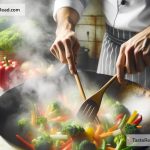Unlocking the Magic of Ancient Grains: A Journey into Quinoa and Freekeh
In the vast universe of food, ancient grains have always held a mystical charm, with their tales rooted in civilizations millennia old. Among these, quinoa and freekeh have emerged as stars, captivating the modern kitchen with their rich nutritional profiles and versatile appeal. If you’ve been eager to diversify your culinary repertoire or simply want to add a nutritious twist to your meals, embarking on a journey with these ancient grains can be transformative. Let’s dive into the simplicity of learning to cook with quinoa and freekeh, grains that possess the power to enchant your cooking with their ancient stories.
Quinoa: The Chameleon Grain
Quinoa, once a staple for the Incas who deemed it the “mother of all grains,” is not a grain in the truest sense but a seed. Its popularity in contemporary kitchens owes to its high protein content, complete with all nine essential amino acids, making it a go-to choice for vegetarians, vegans, and meat-eaters alike.
Cooking quinoa is as easy as it gets. The fundamental ratio to remember is two parts liquid to one part quinoa. Here’s a simple guide to getting it perfectly fluffy each time:
- Rinse your quinoa under cold water to remove its natural coating, saponin, which can give it a bitter taste.
- In a pot, combine 1 cup quinoa with 2 cups of water (or broth for extra flavor) and bring it to a boil.
- Once boiling, reduce the heat, cover, and simmer for about 15 minutes or until the water is absorbed.
- Remove from heat and let it sit covered for 5 minutes, then fluff it with a fork.
Quinoa’s magic lies in its versatility. It can swing from being a satisfying breakfast porridge when cooked with milk and topped with fruits and nuts, to playing the base for refreshing salads, or even substituting rice in sushi!
Freekeh: The Smoky Marvel
Freekeh, a stunning grain with roots in ancient Middle Eastern cuisine, is young green wheat that has been roasted and threshed. Its unique preparation method grants it a delightful smoky flavor and a chewy texture, making it an intriguing addition to the pantry.
Rich in fiber and protein, freekeh is a fantastic ally for those looking to add more plant-based ingredients to their diets. Here’s how to dive into cooking with this ancient grain:
- Just like quinoa, start by rinsing your freekeh to remove any impurities.
- The cooking ratio for freekeh is a bit more generous, needing about 2.5 cups of liquid for every cup of freekeh.
- Combine your freekeh and water (or broth) in a pot, bring to a boil, then cover, reduce the heat, and simmer. Whole grain freekeh will take about 40-45 minutes to cook, while cracked freekeh is quicker, taking about 20 minutes.
- After most of the liquid is absorbed, let it stand covered for a few minutes, then fluff it with a fork before serving.
Freekeh wonderfully showcases its smoky depth in salads, side dishes, or as a base for pilafs. It seamlessly absorbs flavors, pairing splendidly with spices, herbs, nuts, and fruits for a flavorful meal that is both fulfilling and nutritious.
Creative Cookery with Ancient Grains
The beauty of both quinoa and freekeh lies not just in their nutritional benefits but in their ability to transform everyday cooking into an exploration of flavors and textures. Here are a few creative ideas to inspire your culinary adventures:
- Quinoa-stuffed bell peppers: Mix cooked quinoa with black beans, corn, avocado, lime juice, and spices for a delightful stuffing.
- Freekeh breakfast bowl: Cook freekeh in almond milk, and serve with a drizzle of honey, a sprinkle of cinnamon, and fresh berries for a hearty start to the day.
- Quinoa sushi rolls: Use quinoa instead of rice for an added protein punch in your homemade sushi rolls.
- Freekeh salad with roasted vegetables: Combine cooked freekeh with your choice of roasted vegetables, a handful of arugula, and a tangy vinaigrette for a robust salad.
Embracing quinoa and freekeh in your kitchen opens up a world of culinary possibilities, inviting you to experiment, create, and relish dishes that are not just nourishing but also a bridge to the rich tapestry of ancient culinary traditions. Happy cooking!


